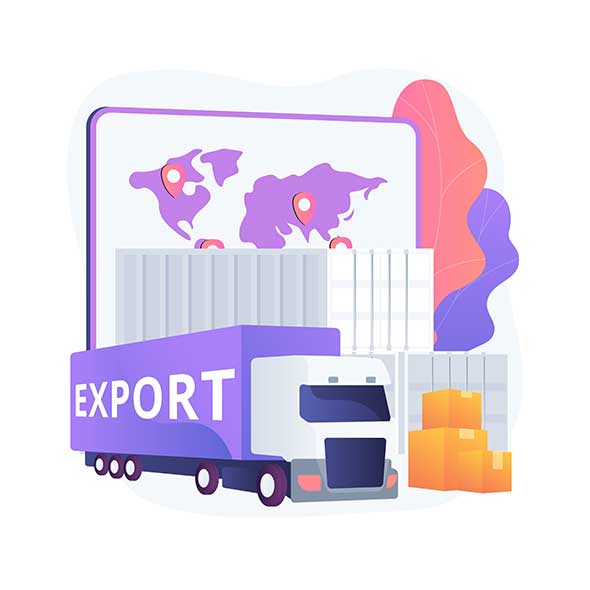
International Logistics
We reach any part of the world
At ETD INOX INDUSTRIES S.L. We are committed to internationalization, offering the development, manufacture and installation of our turnkey projects worldwide, for which we have specialists in international logistics who are in charge of carrying out all types of exports from start to finish that can occur. in a business relationship outside the European Union.
We offer clients from the beginning of the negotiations, advice and management of complete international logistics, as well as the logistics and commercial documentation necessary to carry out international operations successfully and optimizing costs and customs taxation for both parties.
Taxation and logistics documentation systems vary by country, so it is very important that shipments are made by specialists in international logistics so as not to make mistakes, which will lead to heavy economic losses due to customs fines and retention of merchandise. in ports and airports, or due to poor coordination between the parties.


Formalities
To carry out a foreign trade operation, understood as an export to a third country, that is, outside the European Union, it will be necessary to have the services of a logistics operator and a customs agent (they can be the same figure or independent entities ), which depending on the operation may be contracted by ETD INOX or by the client if they so decide.
The function of the freight forwarder is to mediate in the logistics of the operation: it organizes the transport of the merchandise from the exporter’s home to the final destination, carries out customs procedures and offers advice throughout the operation.
Services offered
After closing the agreement with INCOTERM and the corresponding means of payment between us as exporter and the client as importer, we offer the services of:
Advice
Advice by ETD INOX in the realization of the documentation and the most convenient type of export / import for both parties, optimizing taxation.
Negotiation
Negotiation with logistics operators to obtain competitive prices and make the shipment tailored to the client.
Organization
Organization of shipment.
Advice
Follow-up of the shipment
Incoterms
Term that comes from “international commercial terms” which, as its name indicates, are the terms and requirements of an international sale and purchase transaction. Due to this, they are in charge of stipulating when and where the transmission of risks and the obligation in terms of costs occurs, as well as who bears them and other factors in relation to this type of transaction.
These terms are not always the same or remain stable, but from time to time (normally 10 years) they undergo updates to be able to leave behind terms that are no longer used because they have conditions that are not very adapted to today’s market.
Incoterms have a simplifying function: they facilitate negotiation between buyer and seller, since they clarify aspects related to international trade: who pays for transport, where the goods are delivered, who is responsible for customs expenses, etc.
The 11 types of Incoterms effective as of January 1, 2020 are: EXW, FCA, FAS, FOB, CFR, CIF, CPT, CIP, DPU, DAP, DDP.
EXW → Ex Works / At factory
The seller / exporter delivers the merchandise to the buyer in his own warehouses (those of the seller), so he will only have to take care of packing the merchandise.
The buyer / importer bears all expenses and bears all risks from the moment he picks up the merchandise at the seller’s warehouse. Once it leaves the warehouse, before loading it, the buyer has all the responsibilities for the load. The insurance is not mandatory, but if it is contracted it is the responsibility of the buyer, who is the one who assumes the risk.
FCA → Free Carrier
delivers the merchandise to the buyer at a previously agreed point and assumes the costs and risks until the merchandise is delivered at that point, including customs clearance costs for export. That is, the seller is in charge of the internal transport and the export customs procedures, except if the agreed site is the seller’s facilities (FCA warehouse), a circumstance in which it is delivered at that point once loaded in the arranged means of transport. by the buyer, who will bear the cost of the freight.
The buyer, as we have commented, is the one who assumes the expenses from loading on board to unloading, including insurance in the case of hiring it since he is the person who runs the risk when loading the merchandise in the first conveyance.
As a novelty of the FCA with respect to Incoterms 2010 is that when it is used for maritime transport, the buyer can instruct his carrier to issue a BL (Bill of Lading / Bill of Lading) to the seller accompanied by the term “on board” (on board ) to justify the delivery of the merchandise and facilitate the operation of the documentary credits and that the credit is thus paid to the seller as a guarantee of the Bank but which is not a party to the transport contract.
FAS → Free Alongside Ship
The seller, as his name indicates, delivers the merchandise at the loading dock of the port of origin next to the ship where the merchandise will be transported. The seller is the one who assumes all costs until delivery, including export customs formalities.
The buyer is responsible for the cargo while on board the ship, in addition to its stowage, freight and other expenses until it is delivered at destination, including import clearance and insurance (if it has been contracted by agreement between the parties, which is not required). Likewise, he assumes the risks when the merchandise is at the loading dock before loading it onto the ship.
This Incoterm is only used for maritime transport, normally for special products due to their cargo needs. It is not very common in palletized or containerized loads.
FOB → Free On Board
The seller bears all the costs and risks until the merchandise is put on board the means of transport, as well as the export clearance and expenses at origin. On the other hand, he is also in charge of contracting the transport in case it is borne by the buyer.
The buyer is responsible for the costs of freight, unloading, import procedures, delivery to destination and insurance if it has been contracted. The risks are transmitted the moment the merchandise is on board.
The FOB Incoterm is only used for maritime transport and should not be used for merchandise that goes in containers since responsibility is transmitted when the merchandise is loaded on board the ship, that is, when the products physically touch the floor of the ship, But in the case of containers, they are not loaded as soon as they arrive at the terminal, so if the merchandise suffers any damage while it is in the container, it would be very difficult to establish the moment at which it occurred.
CFR → Cost, Insurance and Freight
The seller is responsible for all costs until the merchandise reaches the port of destination, including export clearance, origin costs, freight and usually unloading costs.
The buyer is responsible for the import procedures and internal transport to the destination. He assumes the risks from the moment the merchandise is on board, so it is usually frequent to take out insurance, although it is not mandatory.
It is only used in maritime transport.
CIF → Cost, Insurance and Freight
The seller bears all the expenses until the merchandise arrives at the destination port as well as the CFR (import clearance, expenses at origin, freight and normally the unloading expenses). In addition, the CIF requires insurance from the origin, although the risk is transferred to the buyer at the time the merchandise is on board the ship.
The buyer assumes the import costs for the internal transport to the destination.
This Incoterm includes a novelty in its updated version of 2020 referring to the insurance coverage that the seller has to contract. The insurance coverage must be the same as those provided by Clauses C of the Institute Cargo Clauses, that is, the insurance must cover until the merchandise reaches the port of destination.
On the other hand, it is only used in maritime transport. It is one of the most used since it determines the customs value.
CPT → Carriage Paid To
In the CPT, the seller bears all the expenses until the merchandise is made available to the seller in the place agreed by the two parties, which involves origin costs, export clearance, payment of the main transport and normally, the expenses of destination (eg: inland transport)
The buyer takes care of import procedures and insurance in case it is contracted. As for the risk, it becomes the buyer’s when the merchandise is loaded in the first means of transport contracted by the seller.
The CPT incoterm is suitable for all modes of transport
CIP → Carriage and Insurance Paid
The seller is responsible for the expenses until the products are delivered to the agreed destination, that is, the costs of origin, export clearance, sea freight and insurance, which on this occasion is mandatory.
The buyer, for his part, has to assume the import formalities and delivery at destination. The risk passes when the merchandise is loaded in the first means of transport.
New: There is a modification in the insurance coverage, which in addition to being mandatory, must contain the same coverage as those established by Clauses A of the Institute Cargo Clause. Products have to be insured until they reach their final destination.
DPU → Delivered at place Unloaded
The seller has the costs and risks of all the procedures of origin, that is, packaging, loading, export dispatch, freight, unloading at destination and delivery at the point previously agreed between the parties.
The buyer takes care of all the import clearance formalities.
New: If you already know the old version of these terms (Incoterms 2010) you may have realized that this is a new term that replaces the DAT. The novelty is that delivery alternatives are expanded. Before with the DAT the delivery had to be carried out at the terminal and now with DPU it can be done at any other delivery point that is previously agreed between the parties, without having to be the terminal.
DAP → Delivered At Place
The seller is responsible for all risks and expenses of the deal except import clearance and unloading costs at destination. Therefore, the seller assumes the costs of origin, freight and inland transport. In the event that insurance is contracted (it is not mandatory), the seller would assume the expenses.
The buyer, therefore, only bears the import clearance and unloading costs.
It can be used with all means of transport.
DDP → Delivered Duty Paid
The seller will pay all expenses and risks that take place from the packaging of the merchandise and its corresponding verification in the warehouse until the products reach their final destination, including import and export dispatches, freight and insurance in case they are hire.
The buyer is only responsible for receiving the merchandise and normally for its unloading, although it is not mandatory for him to take care of it, but the buyer can also do it (according to agreement).
As you can see, this Incoterm is the opposite of the EXW, since the seller is the one who assumes all the risks and expenses.
Tips for using Incoterms properly
- Agree on the specific term with the other party before starting transportation.
- Make sure that the term used is suitable for the chosen medium.
- Confirm that both parties understand the obligations indicated in the international sales contract.
- Indicate without errors the type agreed in the commercial invoice of the shipment.
- Periodically check the terms used and review your rights and obligations, if necessary.

Incoterms most used in international transport
FOB (Free on Board)
FCA (Free Carrier)
“Free Carrier” the seller delivers the products that have previously passed through the export office designated by the buyer at an agreed place, if the delivery takes place at the seller’s facilities, it is the seller who assumes the cost of the cargo in the On the other hand, if it takes place elsewhere, the selling party is not responsible.
CFR (Cost and Freight)
“Cost and freight”, designated port of destination: The seller bears the costs and cargo until he reaches the named port. The risk is transferred to the buying party as soon as the products have been loaded onto the ship.
CIF (Cost Insurance Freight)
Cost, insurance and freight (designated port) The seller pays insurance and freight to deliver the goods to the designated place.
Most frequent mistakes when using Incoterms
1. Use of terms that do not exist
With the exception of these eleven terms: EXW, FCA, FAS, FOB, CFR, CIF, CPT, CIP, DAT, DAP, DDP; there is no more, and other alleged incoterms will not be recognized. Using made-up conditions is quite common. Expressions such as EXW Docks, C + F, etc., seem to come from one of the eleven, to which certain stipulations, right and responsibility are varied by eliminating, substituting or implementing some other factor. This is not intentional, it is only due to little knowledge regarding any of these eleven official and current incoterms- The terms must be fulfilled as part of the commercial contract agreed between two parties.
2. Use of Incoterms for national sales contracts
Incoterms are made for international operations. They will be used in contracts for the sale and purchase in which the goods have their origin in one country and their destination in another.
3. Incompletely name the chosen Incoterm
After the three letters, the place specified for delivery must follow, otherwise it has no meaning. It is best to indicate the full address where it must be delivered after the three letters of the, as is, whether it is a kilometer point on a road, a street number, or a postal code. Thus, the exact place where the merchandise will be delivered and all the information related to risks and costs regarding foreign trade, customs duties, means of transport, insurance, etc., that must be assumed by both parties, will be determined without mistakes. it will be clear without any doubt.
4. Use Incoterms not foreseen for the chosen mode of transport
The vast majority of shipments require a combination of two or more modes of transport, being the land by road the one that is used as an auxiliary to the rail, air and sea almost always. The CFR and CIF Incoterms are the clear example. They are intended for use in transactions where all transportation is by sea or inland waterways. In other words, its use would be reserved for goods produced in port terminals or those that travel to these through conduits or pipes, as is the case with solid, liquid and gas bulks. The alternative to CFR and CIF is the use of CPT and CIP respectively.
5. Not assessing the risks for our company in each incoterm
All the provisions carry with them advantages and disadvantages for buyers and sellers, but the shocks will be much less as well as their possible consequences if we try to minimize the risks for our company and knowingthose of us who are finally exposed.
What Incoterm should I use?
It is recommended to use Incoterms with the help of a company with specialized personnel in this type of operation in order to minimize the risks posed by improper or incomplete use.
Commercial documents
The commercial invoice, the list of contents (or packing list), certificates of origin, Eur-1, ATA carnet, etc.
At a minimum, we will always have the first two (or sometimes a single document that incorporates an invoice and content), which must be issued by the exporter. The rest of the documents may be necessary depending on the type of merchandise or its final destination – for example, the certificate of origin or the EUR-1 may be required by the final importer to obtain a benefit in paying the tariff in the country. of destiny.
Depending on the mode of transport, we would basically have the maritime bill of lading, Bill of Lading (BL) or air, Airway Bill (AWB), the ground waybill or CMR, or multimodal bills of lading. In all cases, the knowledge is issued by the freight forwarder or by the sea or airline.
There are also different versions of them that facilitate cargo release and original document management.
The DUA (Unique Administrative Document) is the document used in all international transactions. It is very important that international trade professionals know it well because it offers information on the merchandise, its origin, value, taxes, etc. In addition, it is used to make the tax declaration, both for exports and imports. Without this document, no merchandise can pass through customs in any country in the world.
It is the form that is presented to Customs for clearance. It has the effects of a tax declaration, and hence the importance of the customs agent being competent when specifying it, correctly identifying and classifying the merchandise, its tariff heading, and the amounts to be declared.
It is the common document to make the import declaration in all the member states of the European Union.
It can be presented through a computer system or in person at the designated customs offices.
The DUA must collect:
Identification of the participants in the operation.
- Customs Destination: release for consumption, release for free circulation, transit, temporary importation.
- Goods identification data: TARIC (HS CODE), weight, units, location, packaging.
- Data of the means of transport.
- Country of origin, export and destination.
- Commercial and financial information: incoterms, billing currency, exchange rate, invoiced value.
- List of documents associated with the SAD: commercial invoice, transport document, declaration of customs value, proof of origin, import licenses, inspection certificates (sanitary, veterinary and phytosanitary).
- Declaration and mode of payment of import taxes.
The DUA is made up of 8 copies (numbered from 1 to 8), plus an additional one known as ‘Levante’. Each one has a specific function, depending on the type of exchange in question: export, import, export plus transit, etc.
As detailed by the Tax Agency, for exports, the exporter must present three copies of the SAD:
- Number 1: for the Customs office of dispatch.
- Number 3: for the interested party.
- Number 4: will be presented when it is necessary to justify the Community character of the goods before the Community Customs of destination, Andorra or San Marino. In national exchanges, the corresponding receipt authorized at the electronic headquarters may be printed.
For imports, the DUA to be completed includes the following copies:
- Number 6: for import / introduction Customs.
- Number 8: for the interested.
For transit operations, such as reloading or transshipment of goods, the following copies must be completed:
- Number 1: for the Customs office of dispatch.
- Number 4: for the Customs office of destination.
- Number 5: will be used as a guide for its return to the issuing member state.
Copies 2 and 7 of the SAD have a statistical function, that is, they are used to produce reports on international trade. Copy number 2 is filled in for exports and copy 7 for imports.
The DUA completion process is carried out over the Internet and is subsequently sent electronically to the corresponding authorities. Once delivered, Customs will respond to the request by assigning a channel. This channel determines the type of control that the merchandise must pass:
- Green channel: correct documentation and the merchandise can enter and leave the country.
- Orange channel: documentation should be reviewed.
- Yellow channel: verification of the existence and validity of a specific Border Inspection certificate or authorization required for customs clearance.
- Red channel: checking the merchandise and the documentation provided.

Export taxes
The export of goods to a third country (outside the European Union) is subject to, but exempt from VAT, so the exporter does not pay this tax. However, you must inform the Tax Agency of said operations and for this the DUA and the various models that you must present to the authorities will serve.
